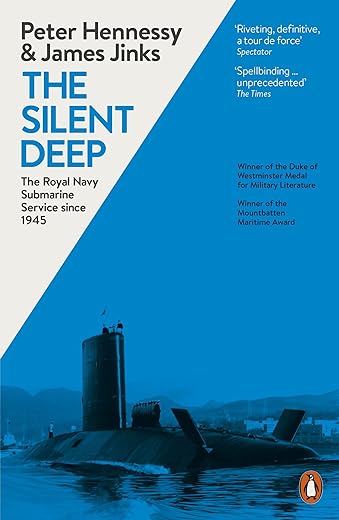The Silent Deep: The Royal Navy Submarine Service Since 1945
£17.10£19.00 (-10%)
‘The Ministry of Defence does not comment upon submarine operations’ is the standard response of officialdom to enquiries about the most secretive and mysterious of Britain’s armed forces, the Royal Navy Submarine Service. Written with unprecedented co-operation from the Service itself and privileged access to documents and personnel, The Silent Deep is the first authoritative history of the Submarine Service from the end of the Second World War to the present. It gives the most complete account yet published of the development of Britain’s submarine fleet, its capabilities, its weapons, its infrastructure, its operations and above all – from the testimony of many submariners and the first-hand witness of the authors – what life is like on board for the denizens of the silent deep.
Dramatic episodes are revealed for the first time: how HMS Warspite gathered intelligence against the Soviet Navy’s latest ballistic-missile-carrying submarine in the late 1960s; how HMS Sovereign made what is probably the longest-ever trail of a Soviet (or Russian) submarine in 1978; how HMS Trafalgar followed an exceptionally quiet Soviet ‘Victor III’, probably commanded by a Captain known as ‘the Prince of Darkness’, in 1986. It also includes the first full account of submarine activities during the Falklands War. But it was not all victories: confrontations with Soviet submarines led to collisions, and the extent of losses to UK and NATO submarine technology from Cold War spy scandals are also made more plain here than ever before.
In 1990 the Cold War ended – but not for the Submarine Service. Since June 1969, it has been the last line of national defence, with the awesome responsibility of carrying Britain’s nuclear deterrent. The story from Polaris to Trident – and now ‘Successor’ – is a central theme of the book. In the year that it is published, Russian submarines have once again been detected off the UK’s shores. As Britain comes to decide whether to renew its submarine-carried nuclear deterrent, The Silent Deep provides an essential historical perspective.
Read more
Additional information
| Publisher | Penguin (2 Jun. 2016) |
|---|---|
| Language | English |
| Paperback | 864 pages |
| ISBN-10 | 0241959489 |
| ISBN-13 | 978-0241959480 |
| Dimensions | 12.7 x 4.06 x 19.69 cm |










by J. J. Bradshaw
There is a lot to like about this book but ultimately it feels rather light (despite it’s physical bulk) and it veers between feeling padded out in places and being very light in others. Some of this is probably unavoidable given the continued secrecy around submarine ops, even those from many, many years ago.
The book opens with a long and detailed account of the authors being on-board a submarine during a perisher course. The perisher course is part of the folklore of the submarine service and it is certainly a subject deserving of serious study in a history of the submarine service however this section managed to feel rather superficial and overlong. Equally, at the end of the book is a very long, padded out account of the authors visit to observe one of the Trident boats test fire a missile which also feels too long and rather superficial.
The book is comprehensive and covers the entire post war period, maybe this is part of the problem, it is just trying to do too much in a single volume. For example, the sections on the technical evolution of submarines feel a bit superficial. There is quite a lot on the RN’s interest in the Walter HTP technology in the post war era but very little on the technology and why it failed. The construction of the nuclear boats, especially the first SSN’s and the Polaris R class could easily justify a complete volume in themselves, the story is told here but again it feels superficial and there is a sense that the authors either do not understand the technology and the challenges faced by the constructors or do not see these areas as being of principal interest to the intended readership.
Cold war intelligence gathering missions are covered in as much depth as we will probably ever get, given the secretive nature of these missions I felt their story was told well. Clearly the cold war wasn’t that cold for submariners despite the low temperatures of Northern waters and the book does give a taste of the very real hazards faced by the crews and the political risks associated with such operations.
The Falklands conflict features prominently, particularly the sinking of the Argentine cruiser General Belgrano, yet the subsequent political controversy around that sinking is almost ignored. This reluctance to get involved with politically controversial aspects of the submarine story extends to the nuclear deterrent, although the reasons for the continuous at sea deterrent policy are explained and the party political games over the number of hulls to build and selection of Polaris, the wider political context and controversies around this most important part of the submarine story are all but ignored I think.
A strength of the book is that it highlights the close relationship between the USN and RN in submarines.
At a strictly practical level, readers need to have a pretty good knowledge of the geography of Northern waters and the waters of the South Atlantic to follow the story as the text is not linked to maps. This is a serious omission that I feel really detracts from the book.
Overall, whilst this review may sound negative, the book has many strengths and does give readers a good introduction and overview to the subject. As noted, in some areas it is unlikely we will ever be told more than we are in this book. I just feel that some judicious editing would have made it more concise and readable without losing real content and that in some areas important topics are brushed over. So not a bad book, but not the definitive work on the subject either.
by Carol Recent purchase
It’s the second book of the same – I couldn’t find my original ….. wonderful service quick and easy
by Amazon Customer
This is an extraordinary book with an encylopediac level of stories about UK nuclear submarine operations that I would have thought were classified, especially in the light of recent political instability. Great detail about nuclear power generators, collaboration (or sometimes lack of) with the US, early diesel subs, jealousies with the surface fleet, hull construction, sonar performance, torpedo development, chasing Russian subs round the world in the cold war, manoeuvres to detect shadowing subs, sonobuoys, accidents and collisions at sea, Mutually Assured Destruction logic, planning for WW3, Human Resource problems, the deliberations of various political leaders from both parties in fleet renewals. The list is exhaustive.
At 700+ pages it’s a bit of a slog to get through and it does tend to wander about from topic to topic within the few long chapters. We are told the colour and style of the buttons on a hot-line telephone instrument at one point which is well over the top. It would have been an easier read if organised in many smaller chapters which could be absorbed one by one on a Kindle reader, where it’s hard to flick about to re-read bits though this is only a personal niggle.
An indispensable read for anyone with any interest in submarines and what the cold war was all about.
by A bookworm
Where to start with this book? It’s well written, has excellent range of accompanying photos and the technical specs of Royal Navy submarines and their Russian counterparts since 1945. In a similar way to NAM Rodger in his Command of the Ocean, the two authors have done a great job of weaving together the different strands of the operational aspects of the Submarine Service, the political aspects of the decisions for Polaris and Trident as well as the technical history of the different class of boats. Each of the chapters are divided well with many sub-chapters, which ensures that the book doesn’t get monotonous, for example when describing the difficulty in dealing with Admiral Rickover or why a PW2 reactor was chosen over a PW1.
The book is well-paced, although occasionally it is noticeable when one author writes one chapter and the other another. That isn’t too say that one is a worse writer than the other, just different styles.
The section on the Falkland’s War, perhaps because of its ‘Hot War’ nature, was particularly interesting, and managing to convey the human element of the submarine campaign as well as the operational. The Cold War missions were also engaging despite the restrictions of the Official Secrets Act. For this reason operational history after the Cold War felt a bit brief, but the in depth look into the successor of Trident made up for it. The authors certain made the most of the cooperation from the Royal Navy and their seemingly all access pass to all parts of submarine service.
It’s difficult to find fault with this book, although a few more maps would have helped when describing some of the operations. That aside, whether you are interested in the politics of the nuclear deterrent, the postwar history of the Submarine Service or the development of such technologically advanced pieces of equipment, then this book should answer all (or at least most) of your questions.